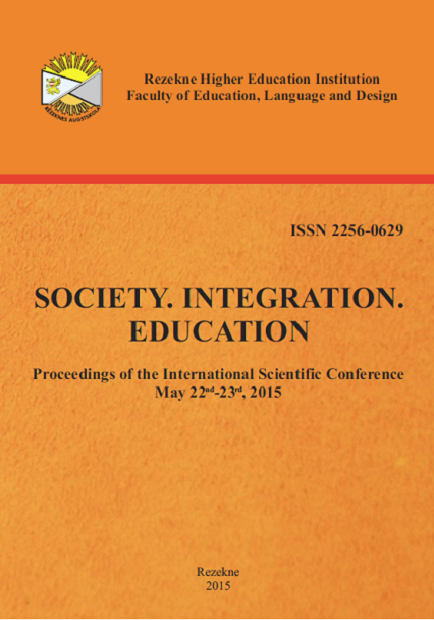Student Creativity Boosting with Innovative Digital Activities to Enhance Study Course Quality
DOI:
https://doi.org/10.17770/sie2015vol1.329Keywords:
English for Specific Purposes (ESP), quality assurance in language learning, ESP course quality criteria, digital tools in language learning, higher education institutions (HEIs)Abstract
The article aims to introduce some digital activities for ESP (English for Specific Purposes) courses and show the effect of their introduction on the quality of study process in an ESP course and on its results. With the help of ESP course quality evaluation model (Rudzinska, 2011) ESP course quality is evaluated along the following criteria: study course clarity, adequacy, cooperation, individual work, variety, and deep approach. Quantitative and qualitative research methods are used to investigate the improvement of study process quality due to the introduction of digital tools. The base of the research are the students of a Latvian higher education institution (HEI) (Institution A) and a Romanian HEI (Institution B), who from 2008/2009 to 2011/2012 studied ESP (Business English and Sports English) with the help of such digital tools as Bighugelabs, Piclits, Glogster, Textivate, Freemind and Wikipedia article creation. In Institution B student satisfaction level with the use of digital tools was surveyed through a 5-point Likert scale questionnaire and oral interviews. In Institution A the students freely reflected on their learning experience with the help of the mentioned digital tools. The results in both HEIs show high student satisfaction with the introduction of digital tools: in Institution B slightly satisfied were 15%, moderately satisfied: 10%, very satisfied: 58%, and extremely satisfied: 15% of respondents. Qualitative analysis showed that ESP course quality due to the introduction of digital tools improved in relation to quality criteria, summarized in the mentioned quality evaluation model (clarity, adequacy, cooperation, individual work, variety, and deep approach), as well as in relation to other quality criteria: accessibility, availability, novelty, variety, creativity, an opportunity to be proud about the results of the work done; the weaknesses were due to lack of accessibility (Internet connection in my village is too slow), lack of creativity (I’m not very creative) and complicated techniques of digital tool application.
References
Al-Jarf, R. (2010). Mind mapping, Presentation, given at International language conference “The importance of learning professional foreign languages for communication between cultures”, Celje, Slovenia: University of Maribor, 6 p.
Blikstad-Balas, M. (2013). Students’ Attitudes Towards Wikipedia as a Knowledge Source in School. Paper presented at ECER 2013, Creativity and Innovation in Educational Research, Available from URL: http://www.eera-ecer.de/ecer-programmes/conference/8/contribution/21636/ (accessed on September 23, 2013).
Jandric, P. (2010). Wikipedia and education: anarchist perspectives and virtual practices. Journal for Critical Education Policy Studies, vol.8. no.2, pp. 48-73, Available from URL: www.jceps.com/PDFs/08-2-02.pdf (accessed: 24.09.2013).
Lasnier, J.C. (2003). Quality, Version 2003, Available from: URL http://www.quiltnetwork.org, 2003 (accessed on May 5, 2007).
Meder, E., Iske, S. (2009). Quality assurance by RQCC: how quality is attributed to the relation between learner and e-learning environment. Proceedings of EDULEARN09 Conference, Barcelona, Spain, July 6-8, 2009.
Oliveira, L.R., et.al. (2013). Data Is A Built Thing: (De)Constructing The Curriculum Through Wikipedia Writing. EduLearn 2013 July, Barcelona, Spain, Virtual participation.
Raine, L. & Tancer, B. (2007). Wikipedia users. Washington, DC: Pew Internet & American Life Project. Retrieved from URL: http://pewinternet.org/Reports/2007/Wikipedia-users.aspx ((accessed on September 10, 2013).
Rudzinska, I. (2011). Promocijas darbs, Latvijas Universitāte: Riga, 2011.
Street, B., 2003. What's "new" in New Literacy Studies? Critical approaches to literacy in theory and practice 2003, Current Issues in Comparative Education, Vol. 5(2).
Szesnat, H. (2006). Who Knows? Wikipedia, Teaching and Research. SBL Forum 4.9 (2006). Available from: URL http://www.sbl-site.org/Article.aspx?ArticleId=603, (accessed on July 20, 2012).
Tardy, C.M. (2010). Writing for the World: Wikipedia as an Introduction to Academic Writing, English Teaching Forum, Vol. 48, No.1, 2010, 12-20.
Wikipedia. 2013. Wikipedia: About. Available from: URL http://en.wikipedia.org/wiki/ Wikipedia: About, August 2013 (accessed: 5.08.2013).






